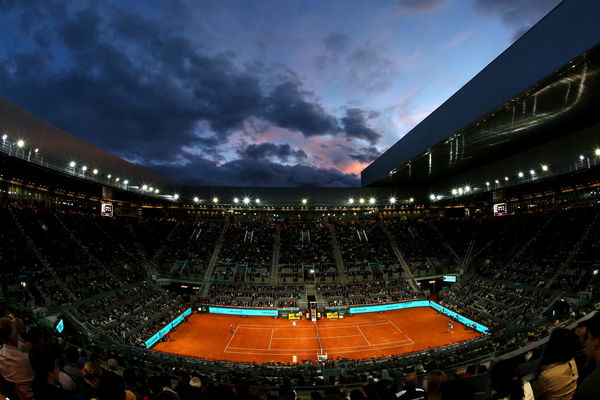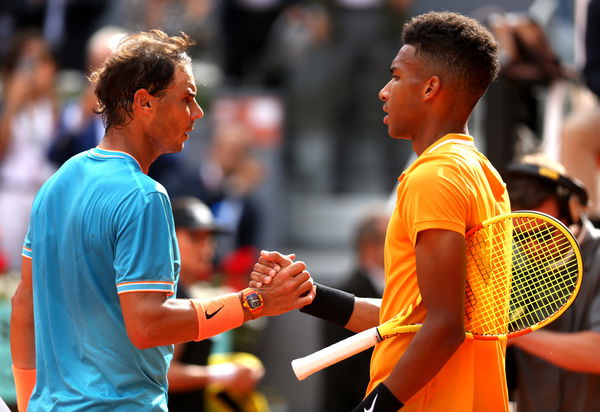
via Getty
A general view during the match between Rafael Nadal of Spain and Francis Tiafoe of The United States during day six of the Mutua Madrid Open at La Caja Magica on May 09, 2019 in Madrid, Spain. (Photo by Alex Pantling/Getty Images)

via Getty
A general view during the match between Rafael Nadal of Spain and Francis Tiafoe of The United States during day six of the Mutua Madrid Open at La Caja Magica on May 09, 2019 in Madrid, Spain. (Photo by Alex Pantling/Getty Images)
This year’s Mutua Madrid Open stands out from the previous editions in more ways than one. For starters, the event is being staged with a reduced crowd and is abiding by a host of other protocols in the new normal amid the novel coronavirus pandemic. However, the most talked-about change is the introduction of Hawk-Eye technology for line calling as opposed to foot inspection by the chair umpire.
Watch What’s Trending Now!
The convention on clay, thus far, had been for the chair umpire to step down from his perch and step across to inspect in the event of a disputed call.
ADVERTISEMENT
Article continues below this ad
Electronic Line-Calling in Madrid Open has marked a departure from tradition on clay
The introduction of Electronic Line-Calling (ELC) at Madrid Open has marked a departure from tradition on dirt and might even be a template for future events. The service is being provided by Foxtenn, the only tech firm which is certified to operate the system on clay.
The system was formally approved and cleared for implementation by the ATP, WTA, ITF as well as the four Grand Slams after being trialed at Rio de Janeiro and Federation Cup matches in the Netherlands and Belarus last year.
ADVERTISEMENT
Article continues below this ad

via Getty
MADRID, SPAIN – MAY 08: Felix Auger-Alliassime of Canada congratulates opponent, Rafael Nadal of Spain, during day five of the Mutua Madrid Open at La Caja Magica on May 08, 2019, in Madrid, Spain. (Photo by Alex Pantling/Getty Images)
The presence of line judges, who are positioned near the baseline, has been called into question, especially in the pandemic times.
“Not had a single mistake,” says top official of the firm providing line tech
Felix Mantilla, Foxtenn’s director of global sales and statistics specialist, said the system was put through several tests and came out with flying colors.
ADVERTISEMENT
Article continues below this ad
“We have not had a single mistake in the pots and that makes the players play more relaxed,” Mantilla said.
On the debate on whether line judges should be persisted with in the days of social distancing, the senior Foxtenn official said, “Our review can be used interchangeably, with or without referees”.
(Quotes have been translated via Google)
The new-age technology for line calls has already been rolled out in as many as 30 tournaments worldwide, including Acapulco, Marseille, Antwerp, New York, Newport and Tokyo.
Explaining how the system works, Javier Simon, founder and CEO of the company, said, “The bounce you see is the real one because we can see the ball from five different angles. There are many footprints, previous bounces, and others that touch lightly on the white line, which can lead to error on land.”
Read More: “Most Difficult Event For Me”: Rafael Nadal on Competing at Mutua Madrid Open 2021
It’s been so far so good with the system at the Madrid Open as it has not drawn any complaints yet.
ADVERTISEMENT
ADVERTISEMENT
ADVERTISEMENT
ADVERTISEMENT


